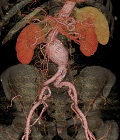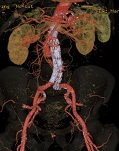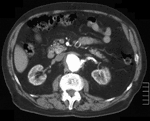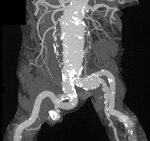Abdominal Aortic Aneurysms

An aneurysm is a stretching of a weakened artery, which balloons out. The wall of the artery becomes thinned by loss of its elastic tissue and the artery then inflates making it likely to burst. The most common artery to be affected is the aorta, which is the main artery in the abdomen. In England and Wales, between 6,000 and 10,000 people each year suffer from rupture of an abdominal aortic aneurysm. Most of these patients are men over the age of 60 years.
Smoking and high blood pressure are known to increase the risk of both developing an aneurysm and it's subsequent rupture.
There is no doubt that the results in patients who have an elective (planned) repair are far superior to those in whom the repair is undertaken as an emergency.
Most are discovered as an incidental finding, during the course of another examination.
The diagnosis is then confirmed by an ultrasound examination and or a CT scan. Not all aneurysms need an operation. The risk of rupture and therefore the need for repair, depends on the size of the aneurysm. If the aneurysm is large (more than 5.0cms in diameter), it is probably safer to have an operation to repair it than to leave it alone. This protects the aorta from rupture.
Smaller aneurysms are usually observed by repeat scanning at 6 to 12 monthly intervals, in case they enlarge and become dangerous. Average enlargement is about 0.5cm per year, so surgery may be required at a later stage.
AAA - Endo-vascular Repair (EVAR)

The endovascular technique is undertaken through a smaller incision in the groin and the graft is passed up the aorta and anchored using a stent. Catheters are inserted in the incisions to guide and deliver a stent-graft through the blood vessels to the aneurysm. An endovascular stent graft is a fabric tube supported by metal wire stents (also called a scaffold) that reinforces the weak spot in the aorta.
Using X-ray guidance, the surgeon places the graft in the area of the aneurysm. The graft is then opened up inside the aorta and held in place with metal hooks and stents rather than sutures (stitches). By tightly sealing the area above and below the aortic aneurysm, the graft allows blood to pass through it without pushing on the aneurysm.
Not all aneurysms are suitable for EVAR repair
The procedure usually takes a couple of hours to perform and patients are usually eating and drinking on the same afternoon following the procedure.
This technique was first undertaken in 1992 and is still developing. Although 30 day mortality results are excellent there is some debate about it's long term outcome. Initial optimism has now been tempered with caution.
AAA - Open Surgery

Surgical treatment involves the insertion of a tube made of a very strong cloth like material called Dacron. The operation is done through an incision in the abdomen. The stretched part of the aorta is then replaced with the tube and sutured into place.
This technique (inlay graft) has been well tried and tested having been established over 40 years ago.
The operation involves a short planned post-operative stay in ITU/HDU and an overall stay in hospital of 5-7 days.

Technique of choice if you are otherwise fit and healthy.
There is risk to life and limb but the main advantage of this techniques is that once done, it will last you the rest of your life.
AAA - Other Information
You may find the following of interest and they can be printed at your convenience.

Peri-operative Information Sheet (pdf)
Giving Consent to an Operation (pdf)
Circulation Foundation - an excellent UK site
EVAR animation - from one of the many device manufacturers
Medline®. - more about aneurysms.